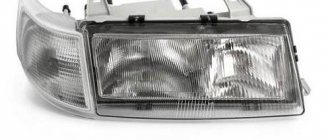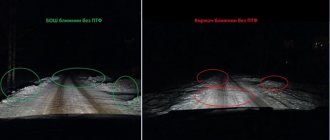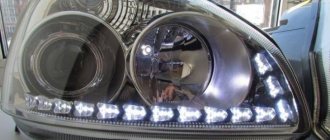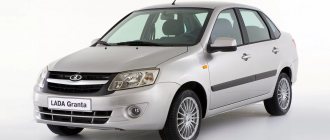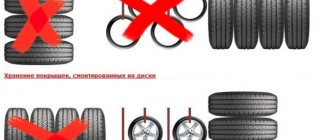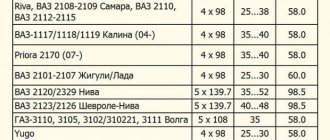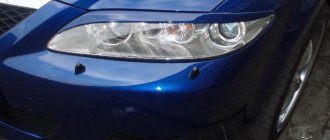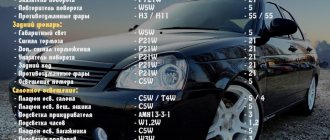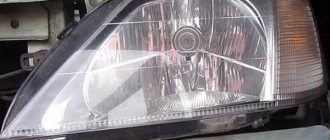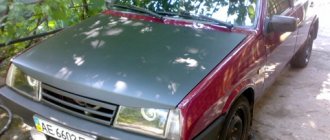Fog lights and lights
This type of light source is part of the overall vehicle lighting system. Lighting equipment is designed for more intense illumination of the road at night, as well as in bad weather, when the visible distance is insufficient for safe movement. This system includes:
- Headlights, taillights and brake lights.
- Car showroom lighting, glove compartment lighting, luggage compartment lighting.
- Front fog lights and rear fog lights.
- Illumination of registration plates and information control panel instruments.
Is it possible to drive during the day with side lights instead of low beams?
June 5, 2021
First of all, let's turn to the main road law - the Rules of the Road. So, paragraph 19.5 reads: “ During daylight hours, low-beam headlights or daytime running lights must be turned on on all moving vehicles for the purpose of identifying them.”
At the same time, the Rules clearly allow for one possibility of replacing the low beam - clause 19.4. allows the use of fog lights instead of low beam headlights.
Thus, during the day you should have either low-beam headlights, fog lights, or daytime running lights on in front. There is no mention in the traffic rules that there are enough side lights during the day.
How to distinguish side lights from DRLs?
Let's say you're buying a car, new or used, and want to determine whether it has DRLs.
Running lights are fundamentally different from conventional side lights, both in their greater brightness and mode of operation.
Even if the car’s lighting control is in the “OFF” position, when the engine starts, the DRLs light up themselves, and when the headlights are turned on, they either reduce their brightness or turn off completely.
Light and law
Although the Rules have put everything in its place, many car enthusiasts are trying to modify their old cars that do not yet have standard DRLs. What is the reason? The fact is that the need to burn low beam lamps all day can lead to the fact that you are much more likely (especially if your light sources are halogen) to be left with one functioning headlight. And then any inspector on the road at night can stop such a one-eyed car, fine the driver, and even prohibit further movement. And he will be right! According to paragraph 2.3.1, “it is prohibited to drive with the headlights and tail lights off (absent) in the dark or in conditions of insufficient visibility.”
In other words, either learn to change a headlight bulb in the dark, under the snow, in the cold, and quickly, like assembling a Kalashnikov assault rifle, or take care of the low-beam headlight bulbs. Therefore, during the day I advise you to drive with fog lights or DRLs. The owner can install the latter independently or in a car service center, but the requirements for the placement and brightness of such lights must be met.
Types of foglights
According to traffic regulations, the use of fog lights is officially permitted; many manufacturers equip factory-produced cars with fog lights. But many universal types are also produced by third-party companies. By type there are:
- Front fog lights;
- Rear fog lights.
The design features differ in the source of light used. Common types of fog lights:
- Halogen. Relatively inexpensive light sources, in demand among car enthusiasts. The disadvantages include the short service life of the lamps. During intensive use, they require frequent replacement;
- Xenon. The characteristics of the light spectrum are better than those of halogen lamps. They work long enough. The price is quite high;
- LED fog lights. The highest price category. Lamps with excellent light beam. They have a long service life. Lamps are prone to overheating. Requires fairly good ventilation.
How to determine the visibility limit?
The use of fog lights is strictly regulated by traffic regulations. Poor visibility of the roadway is when the visibility to the car in front is less than 300 meters at dusk, as well as in a situation where it is raining, foggy or snowing heavily. How can you tell by eye in bad weather that visibility is limited? It is necessary to count the power line supports that are installed along the road. If less than 6 pieces are visible, then the view is difficult and is less than 300 meters. The distance between the pillars is fifty meters. In such conditions, it is necessary to reduce the speed of the vehicle and be extremely careful.
When are fog lights used?
According to standard No. 19.4 of the Traffic Regulations, front fog lights are designed for additional illumination of the roadway at night or when dusk falls, together with headlight devices. Use is permitted in unlit areas or in conditions of limited visibility caused by weather conditions. And also as running lights, instead of low beam, according to paragraph No. 19.5, during the day. A detailed explanation of traffic rules and GOST can be read in this article: https://businessman.ru/new-dnevnoj-xodovoj-ogon-razyasnenie-gost-i-pdd.html. Separate regulations apply to the operation of rear lights. When according to traffic regulations do you turn on the fog lights installed at the rear of the car? Rear fog lights are intended only for additional identification of the vehicle in conditions of poor visibility: fog, snowfall, heavy rain, etc. Turning on in normal situations is prohibited.
What does the law say on this issue?
The Traffic Rules contain information on this matter. Clause 19.5 states that during the day, low-beam or daytime running lamps must be turned on to indicate vehicles on the highway. The possibility of replacing low-beam headlights with fog lights is strictly stated in clause 19.4. These rules must be followed by all road users.
As a result, we can say that the driver’s car should light up during the day:
- low beam headlights;
- fog lights;
- Daytime Running Lights.
It turns out that Russian legislation clearly states that fog lights can be used during the day. Such actions are not a violation.
Installation
It is worth paying attention to the correct installation of additional lighting sources. Installation of fog lights according to traffic regulations in Russia has some features and limitations:
- The emitted light should be in the milky white spectrum or have a bright yellow color.
- Installation of only paired directional light sources is permitted. The type of lamp used must be of the same type.
- Installation of an additional device is possible no higher than the level of stationary car headlights. The lowest point should be higher than 25 centimeters from the surface of the roadway.
- According to the dimensions of the vehicle, the separation cannot exceed 40 cm (for a vehicle width of 1.3 m) and 60 cm (for others).
- The connection of the fog lights must be connected to a separate toggle switch.
- The angle of the emitted light beam should be between -10 and +15 degrees vertical.
- The horizontal angle should be between -10 and +45 degrees.
The rules do not regulate the exact installation location.
Rear fog lights
It is prohibited to connect rear fog lights together with brake lights. It is also not allowed to turn on the rear fog lights if the overall visibility is equal to or higher than 300 meters. Such restrictions have objective reasons. The brightness of the rear fog light sources is the maximum of all the lights present in the rear of the vehicle. They are even brighter than brake lights. With sufficient visibility in normal weather conditions, they cause blinding of drivers behind the cars. It is also strictly unacceptable to combine the buttons for turning on and off the front and rear fog lights.
How should we use lighting devices today?
So, the traffic rules today regulate the following rules for the use of headlights.
Night time:
- low or high beam (see below conditions when you cannot use high beam) when driving,
- near and/or rear PTFs together with dimensions when parking on unlit sections of roads (it is not necessary to turn on the near ones, but the dimensions are required),
- only on unlit roads and only together with a neighbor or a distant driver.
Insufficient visibility (fog, rain, etc.):
- low or high beam (see below conditions when you cannot use high beam) when driving,
Daylight hours (any of the following):
- Daytime Running Lights,
- dipped headlights,
- front fog lights.
There is no need to turn on the taillights during the day.
Tunnels:
- low or high beam (see below for conditions when high beam cannot be used).
When not to use high beam headlights:
- on an illuminated road in populated areas,
- closer than 150 meters from oncoming traffic,
- further than 150 meters from the oncoming traffic, if the driver of the oncoming car blinks his headlights,
- in any case where you may blind drivers.
Direct blinding of pedestrians by distant traffic regulations is not prohibited.
Additional LED lights
What do the regulations say about installing LED fog lights?
To answer this question, let's start with the main headlights. Is it possible to change the headlight bulbs recommended by the manufacturer to xenon or LEDs? Traffic regulations give a precise answer: if the manufacturer recommends or could install non-halogen light diffusers on the conveyor for a specific car model, then “upgrading” is permissible. To put it simply, everything that is included in the vehicle configuration is permissible, everything that is not provided is prohibited. If you simply replace halogen lamps with LED fog lamps, then due to the design features of the headlight (the diffuser lens only works correctly with the lamp intended for it), there will be almost no good effect. The headlights will, of course, emit more light, but the beam formation will be incorrect. It will not be possible to achieve the desired result without replacing the headlights themselves, except for blinding oncoming drivers.
All the same rules apply to fog lights with LEDs. The installation of fog lights not provided by the manufacturer according to the traffic rules (Article No. 12, paragraph No. 5) provides for punishment. It is illegal to operate a vehicle with lights that are not designed for a specific model. Will lead to deprivation of a driver's license for a period of 6 to 12 months with confiscation of light sources.
Photos provided by the Internet agency "DreamTrade"
When do you need to turn on which headlights according to traffic regulations?
In Section 19 of the Rules, a citizen can obtain all the information he is interested in regarding the procedure for using lighting devices.
In the city
There are not many regulations in Section 19 of the Rules that regulate any differences in the use of headlights and lanterns in the city and outside it.
During the daytime
Government Decree No. 316 of May 10, 2010 “On the Introduction...” regulated some amendments to paragraph 19.5 of the Rules.
If, as amended by Rules No. 15 dated February 24, 2010 (not currently in force), clause 19.5. obligated all drivers outside cities, as well as drivers in cities, to turn on low beams, but only under certain conditions (when driving in a convoy, when transporting children in groups, etc.), then in the current edition (No. 56 of May 30, 2021) the requirements have become more stringent .
In particular, from 2010 to the present day, low-beam lights (or daytime running lights) must be turned on during the day on all vehicles - regardless of where they are - in the city or outside the populated area.
However, there is a slight relaxation - drivers can drive with fog lights within the city (and outside it too). In this case, the low beam can be turned off.
However, driving with only “foglights” (without low beams turned on together with them) is prohibited in the following cases:
- in case of insufficient visibility;
- when driving in a tunnel;
- in the dark (in the evening or at night).
At night
The main requirement is that at night or in the evening (during the dark), in a tunnel, as well as in the presence of insufficient visibility (regardless of where the driver is - in the city or outside it), the car must have the following on:
- or low beam;
- or distant.
The driver himself decides which light to drive on (low or high). It is known that high beams are used in most cases in the absence of street lighting in the city to create better visibility. Also, the long-distance one is indispensable in unlit areas of the country road.
Despite the fact that the driver is given the right to choose which light to drive, it is still necessary that the requirements of clause 19.2 be met. Rules regulating the obligation to switch high beams to low beams when:
- driving in the city on a lighted road;
- oncoming traffic at a distance of at least 150 meters from the vehicle;
- greater distance to the oncoming vehicle, provided that the driver signals the need to turn off the high beam (by alternately turning on and off the high beam);
- any cases of danger of blinding passing or oncoming drivers.
In other cases, high beams are permitted to be used without any additional restrictions.
In poor visibility
The concept of “poor visibility” is not presented in the Rules, but the concept of “insufficient visibility” is presented, which can be found in clause 1.2. Rules
It says that insufficient visibility is less than 300 meters of the road in conditions of rain, fog, snowfall and other adverse weather conditions, as well as at dusk.
P. 19.1. The rules in this case oblige drivers to include:
- or low beam;
- or long-distance (subject to compliance with the requirements of clause 19.2 of the Rules).
Fog lights can be turned on together with the low (or high) beam (paragraph 2 of clause 19.4 of the Rules).
In the country
The requirements for the use of external lighting devices outside the city are almost the same as within the city.
The main difference is in the order in which the high beams are applied. In particular, high beams outside cities can be turned on even if the road is illuminated (paragraph 2 of clause 19.2 of the Rules).
